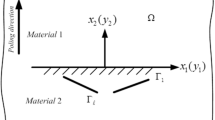Abstract
The problem of finite bimaterial plates with an edge crack along the interface is studied. A complex variable boundary element method is presented and applied to determine the stress intensity factor for finite bimaterial plates. Using the pseudo-orthogonal characteristic of the eigenfunction expansion forms and the well-known Bueckner work conjugate integral and taking the different complex potentials as auxiliary fields, the interfacial stress intensity factors associated with the physical stress-displacement fields are evaluated. The effects of material properties and crack geometry on stress intensity factors are investigated. The numerical examples for three typical specimens with six different combinations of the bimaterial are given.
Similar content being viewed by others

References
Chen, Y.Z. (1983). An investigation of the stress intensity factor for a finite internally cracked plane by using the variational method. Engineering Fracture Mechanics 17, 387–394.
Chen, Y.Z. and Hasebe, N. (1994). Eigenfunction expansion and higher order weight functions of interface cracks. Journal of Applied Mechanics 61, 843–849.
Hutchinson, J.W., Mear, M.E. and Rice, J.R. (1987). Crack paralleling an interface between dissimilar materials. Journal of Applied Mechanics 54, 828–832.
Lee, K.Y. and Choi, H.J. (1988). Boundary element analysis of stress intensity factors for bimaterial interface cracks. Engineering Fracture Mechanics 29, 461–472.
Murakami, Y., (ed) (1989). Stress Intensity Factors Handbook, Pergamon Press, New York.
Rice, J.R. (1988). Elastic fracture mechanics concepts for interface cracks. Journal of Applied Mechanics 55, 98–103.
Sih, G.C. and Rice, J.R. (1964). The bending of plates of dissimilar materials with cracks. Journal of Applied Mechanics 31, 477–482.
Williams, M.L. (1959). The stresses around a fault or crack in dissimilar media. Bulletin of the Seismological Society of America 49, 199–204.
Woo, C.W. and Wang, Y.H. (1992). Analysis of an edge crack in a finite bimaterial plane. Engineering Fracture Mechanics 42, 289–297.
Yau, J.F. and Wang, S.S. (1984). An analysis of interface cracks between dissimilar isotropic materials using conservation integrals in elasticity. Engineering Fracture Mechanics 20, 423–432.
Yuuki, R. and Choi, S.B. (1989). Efficient boundary element analysis of stress intensity factors for interface cracks in dissimilar materials. Engineering Fracture Mehcanics 34, 178–188.
Author information
Authors and Affiliations
Rights and permissions
About this article
Cite this article
Ping, S.J., Hui, L.X. & Heng, C.Y. A complex variable boundary element method for solving interface crack problems. International Journal of Fracture 96, 167–178 (1999). https://doi.org/10.1023/A:1018684831763
Issue Date:
DOI: https://doi.org/10.1023/A:1018684831763



